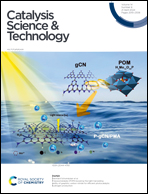One-pot synthesis of an ultrafine Cu2O nanocrystal/porous polymer heterostructure for photocatalytic hydrogen production†
Abstract
Owing to the high surface energy of nano-sized materials, the controllable synthesis of ultrafine and uniform cuprous oxide (Cu2O) nanocrystals (NCs), which show intrinsic advantages in photochemical conversion, still remains a challenge. Herein, by subtly optimizing reaction conditions and designing organic monomers, we successfully synthesize uniformly-sized and well-dispersed Cu2O NCs (ca. 2.7 nm) on a nanoporous triazole polymer to construct an inorganic/organic heterostructure in a one-pot “click” reaction for the first time. The support of the underlying polymer layer can not only suppress the aggregation and ripening of Cu2O NCs but also enable their good stability in air, which is confirmed by the well-maintained XRD pattern after 1.5 months. Mechanistic studies reveal that the formation of type-II band alignment between Cu2O NCs and the triazole polymer promotes charge separation and migration in the inorganic/organic heterostructure, thus improving the activity of visible-light-driven H2 production in the absence of external cocatalysts. This work provides guidance for the facile synthesis of well-defined heterostructures towards facilitated photochemical conversion.



 Please wait while we load your content...
Please wait while we load your content...